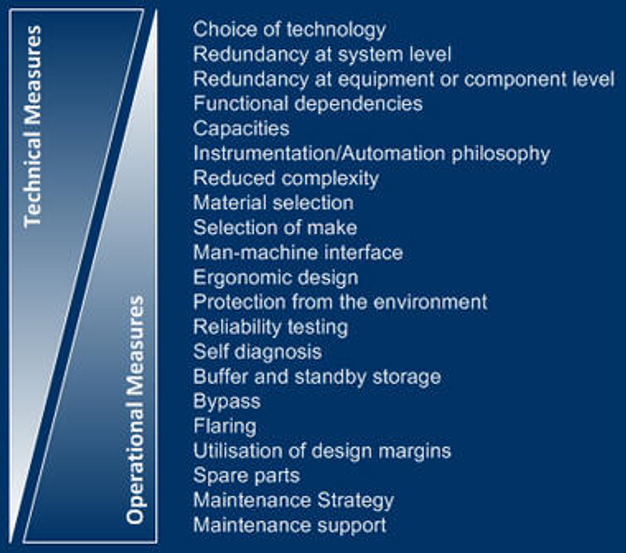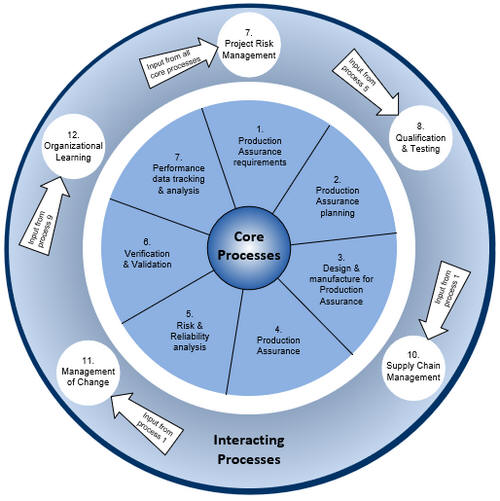|
|
|
|
International Standards and OR&A™
BS EN ISO 20815 - Production
Assurance and Reliability Management See chart showing ISO standards applicable to Oil & Gas Projects
Introduction The long term profitability of these ventures is dependent upon the reliability, availability and maintainability of the systems and components that are used, to ensure the asset created is capable of generating the Production Revenue required to repay the CAPEX and the cost of keeping the asset in operation (OPEX). Therefore, for optimal production availability in the oil and gas business, a standardized, integrated approach is required. According to ISO 20815, the concept of production assurance introduced in this International Standard, enables a common understanding with respect to use of reliability technology in the various life-cycle phases and covers the activities implemented to achieve and maintain a performance level that is at its optimum in terms of the overall economy and, at the same time, consistent with applicable regulatory and framework conditions. The standard describes processes and activities, requirements and guidelines for systematic management, effective planning, execution and use of production assurance and reliability technology intended to achieve cost effective solutions over the life cycle of an asset-development project structured around the following elements: - Production Assurance management for optimum economy of the facility through all of its life-cycle phases, while also considering constraints arising from health, safety, environment, quality and human factors; - Planning, execution and implementation of reliability technology; - Application of reliability and maintenance data; - Reliability-based design and operations improvement. The standard identifies 12 processes, of which seven are defined as core production assurance processes addressed in the standard with a further five processes are denoted as interacting processes and outside the scope of the standard. The interaction of the core Production Assurance processes together with these interacting processes, however, is within the scope of this International Standard as the information flow to and from these latter processes is required to ensure that the Production Assurance requirements can be fulfilled. However, the only requirements mandated by this International Standard are the establishment and execution of the Production Assurance Program (PAP).
Assurance Framework (from ISO
20815) The illustration below lists 21 factors that, to a greater or lesser degree, can have an effect on production performance. Some of these factors are purely technical and it is necessary that they be adhered to in design; others are related purely to Operations.
Design and Operation measures that can affect Production Performance Most of the factors have both technical and operational aspects, e.g. a bypass cannot be used in the operational phase unless provisions have been made for it in the design phase. In addition, there are dependencies between many of the listed factors. This imposes two important recommendations for production assurance to be efficient. - Production Assurance should be carried out throughout all project design and operational phases; - Production Assurance should have a broad coverage of project activities.
Optimization Process The achievement of high performance is of limited importance unless the associated costs are considered. This International Standard can, therefore, be considered together with ISO 15663 (Petroleum and Natural Gas Industries -- Life-Cycle Costing). Examples of constraints and framework conditions that affect such optimization process activities are: - Statutory health, safety and environmental regulations; - Requirements for safety equipment resulting from the risk analysis and the overall safety acceptance criteria; - Requirements to design or operation given by statutory and other regulatory bodies' regulations; - Project constraints, such as budget, implementation time, national and international agreements; - Conditions in the sales contracts; - Technical constraints. The optimization process can be seen as a series of steps, as follows: a. Assess the project requirements and generate designs that are capable of meeting the project requirements; b. Identify all statutory, regulatory and other framework requirements that apply to the project; c. Predict the appropriate production-assurance parameters; d. Identify the preferred design solution based on an economical evaluation/analysis, such as net present value analysis or another optimization criterion; e. Apply the optimization process as illustrated in Figure 2. Be aware that the execution of the optimization process requires that the production assurance and reliability function be addressed by qualified team members; f. If required, the process can be iterative, where the selected alternative is further refined and alternative solutions identified. The iterative process is typical for “gated” or threshold project-execution phases; g. Sensitivity analyses may be performed to take account of uncertainty in important input parameters. ISO 20815 divides Production Assurance processes into two main classes, 'core' processes and 'interacting' processes. This is to illustrate those processes which normally fall under a responsible discipline (e.g. QA, HSE etc.) and those processes that do not. At this point, the concept of ISO 20815 becomes thoroughly confused. The OR&A Solution however, treats all of these processes as part of the systematic approach to OR&A.
ISO 20815 'Core' and 'Interacting' Production Assurance Processes
Production Assurance Program
Objectives (from ISO20815) As Production Assurance is a continuous activity throughout all life-cycle phases, it shall be updated as and when required. It may contain the following: - Systematic planning of production-assurance work within the scope of the programme; - Definition of optimization criteria; - Definition of performance objectives and requirements, if any; - Description of the production-assurance activities necessary to fulfil the objectives, how they are carried out, by whom and when; - Statements and considerations on interfaces of production assurance and reliability with other activities; - Methods for verification and validation; - A level of detail that facilitates easy updating and overall coordination. Annex A of the ISO20815 Standard suggests a model for the contents of a Production Assurance Program (PAP). However, it also maintains that the PAP is the only mandatory deliverable from this International Standard.
Production Assurance Program
(PAP) Activities Processes and activities shall be initiated only if they are considered to contribute to added value of the project. The production-assurance activities specified in the PAP shall be defined in view of the actual needs, available personnel resources, budget framework, interfaces, milestones and access to data and general information. This is necessary to reach a sound balance between the cost and benefit of the activity. Production Assurance should also consider organizational and human factors as well as technical aspects. Whereas the standard emphasises the need for a systematic, risk based approach to Production Assurance, it stops short of explaining how this can be implemented in a real-life project where each of the phases of a project is controlled and managed by different parts of an organisation, (i.e. Feasibility, FEED and EPC are often entirely divorced with a contractual handover at the end of each stage. Similarly, the handover from EPC to Operations is often performed in the same way.).
Conclusion Whilst this is all good information, it has the effect of mixing several clearly defined disciplines without assigning the responsibility for any of them to a particular group, role or person. The majority of the content of this standard is more usually prepared as a written Operations Philosophy in the early phases of a project which is then developed as the project progresses through the project phases. The content is essentially the same as that proposed for a PAP, but it has to be said that the recognition of the need for the Flawless process and the concept of LOSTREV (lost revenue due to lost or deferred production) is long overdue. Furthermore, the acronym PAP is typically used to describe the Project Assurance Plan whereas the term Operations Assurance Plan (OAP) is used to describe a document which contains much of the content referred to in the ISO 20815 standard. The subject of Risk Management for a Project is usually addressed in the Project Risk Register and the Project Risk Management Plan whereas the subject of Operational Risk is addressed in the Flawless Project Initiatives component of Operations Readiness during the project and transferred to the Operations Team upon completion and handover. All of the risks mentioned in the standard are described as occurring during the Project phases whereas only some are carried on to the OPERATE phase and become part of the Risk Management System for the asset (usually managed by the HSE Team). Finally, although this standard contains some very valid information, it is not presented as a workable solution. The entire content of this 'process' is far better represented by the Operations Readiness and Assurance ( OR&A) discipline, especially when supported by a robust management system such as the OR&A Solution. In any event, all such systems require Management Support in two forms: - A Management directive that makes the process mandatory; - A budget to make it possible to deploy the process effectively. Operations Readiness & Assurance ( OR&A) The text within the ISO 20815 standard includes the statement that:
'The objective associated with
systematic production assurance is to contribute to the alignment of
design and operational decisions with corporate business objectives. There is a clear message buried in the text of the standard that needs to be brought out if the standard is to achieve its stated purpose. Fortunately, although the standard fails to introduce a method or system that can be used to deploy and implement the objectives and processes described in the standard, there is a commercially available product which can be used to do just that. The entire content of ISO 20815 is embedded in the OR&A Solution. This did not happen because one system incorporated the content of the other, but that the OR&A Solution was developed over many years with experience from hundreds of projects to compile a 'Best Practice' tool. Both ISO 20815 and the OR&A Solution contain a great deal of good information, the difference is that the OR&A Solution is also a tool by which the process can be deployed, implemented, measured and managed. So, to deploy ISO 20815 on a project, use the OR&A Solution. |
|
|
© OR&A™ |


